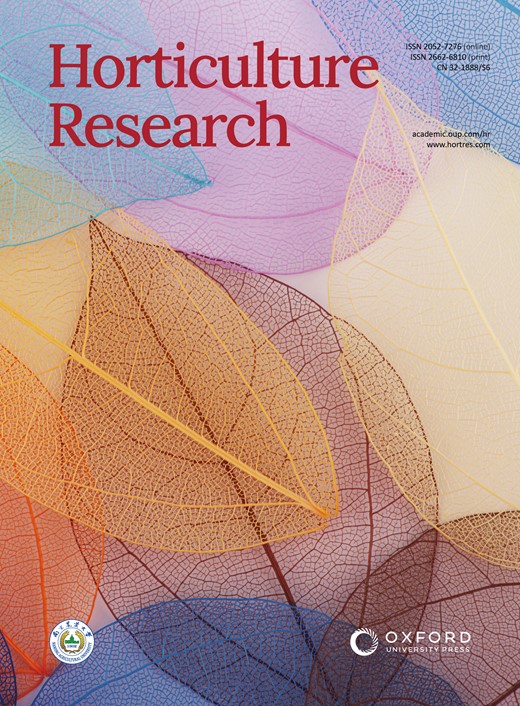多组学分析揭示了分层和嫁接对‘茶柑’黄酮合成和积累的影响
IF 8.5
1区 农林科学
Q1 Agricultural and Biological Sciences
引用次数: 0
摘要
广东网状柑橘果皮是亚洲著名的药用和食品原料,由柑桔(Citrus reticulata ' Chachi)干燥成熟的果皮制成。结直肠癌的主要繁殖方法是层接和嫁接。一般认为,层栽结直肠癌的质量要优于嫁接结直肠癌。然而,分层和嫁接对结直肠癌果皮中主要生物活性成分类黄酮生物合成的影响尚不清楚。通过代谢组学分析,揭示了分层、自嫁接和异嫁接(作为砧木)对两个主要采收期柑桔(Citri Reticulatae Chachiensis Viride)和红柑桔(crri Reticulatae Chachiensis Reddish)黄酮类生物合成的影响。与CRCR相比,CRCV的黄酮含量更高。嫁接结CRC的橙皮苷、褐皮素、橘皮素、红皮素、去甲基褐皮素和枳实素的含量高于嫁接和自嫁接。这种增加可归因于参与类黄酮合成的基因的上调。进一步,在基因共表达网络中发现转录因子CrcMYBF1,证实其可被茉莉酸甲酯(MeJA)显著诱导,通过与其启动子区相互作用上调Crc1,6RhaT的表达,从而促进了柑皮苷的生物合成和积累。总之,我们的研究结果为通过MeJA诱导CRC中CrcMYBF1协调调节橙皮苷生物合成提供了机制见解。本研究有望为大肠癌的繁殖和栽培提供理论依据。本文章由计算机程序翻译,如有差异,请以英文原文为准。
Multi-omics analyses reveal the effects of layerage and grafting on flavonoid synthesis and accumulation in Citrus reticulata ‘Chachi’
Guangdong Citri Reticulatae Pericarpium from the dry and mature peel of Citrus reticulata ‘Chachi’ (CRC) is a well-known medicinal and food materials in Asia. The main propagation methods of CRC are layerage and grafting. It is generally considered that the quality of CRC from layerage is superior to that obtained from plants propagated by grafting. Nevertheless, the effects of layerage and grafting on main bioactive ingredients flavonoid biosynthesis in peel of CRC keep unknown. Here, metabolomic analyses revealed the effects of layerage, self-grafting and heterografting (C. limonia as rootstock) on flavonoid biosynthesis in CRC from two main harvesting periods, CRCV (Citri Reticulatae Chachiensis Viride) and CRCR (Citri Reticulatae Chachiensis Reddish). Compared with CRCR, CRCV exhibited a higher content of flavonoids. Grafting CRC onto C. limonia exhibited a higher content of hesperidin, nobiletin, tangeretin, narirutin, demethylnobiletin and sinensetin, than layerage and self-grafting. This increase can be attributed to the upregulation of genes involved in flavonoid synthesis. Further, the transcription factor CrcMYBF1 was identified within the gene co-expression network and is confirmed to be significantly induced by methyl jasmonate (MeJA) and up-regulate the expression of Crc1,6RhaT through interacting with its promoter region, thereby boosting the biosynthesis and accumulation of hesperidin. In summary, our findings provide mechanistic insights into the coordinated regulation of hesperidin biosynthesis via MeJA inducing CrcMYBF1 in CRC. Our study is expected to provide a theoretical basis for CRC propagation and cultivation.
求助全文
通过发布文献求助,成功后即可免费获取论文全文。
去求助
来源期刊

Horticulture Research
Biochemistry, Genetics and Molecular Biology-Biochemistry
CiteScore
11.20
自引率
6.90%
发文量
367
审稿时长
20 weeks
期刊介绍:
Horticulture Research, an open access journal affiliated with Nanjing Agricultural University, has achieved the prestigious ranking of number one in the Horticulture category of the Journal Citation Reports ™ from Clarivate, 2022. As a leading publication in the field, the journal is dedicated to disseminating original research articles, comprehensive reviews, insightful perspectives, thought-provoking comments, and valuable correspondence articles and letters to the editor. Its scope encompasses all vital aspects of horticultural plants and disciplines, such as biotechnology, breeding, cellular and molecular biology, evolution, genetics, inter-species interactions, physiology, and the origination and domestication of crops.
 求助内容:
求助内容: 应助结果提醒方式:
应助结果提醒方式:


